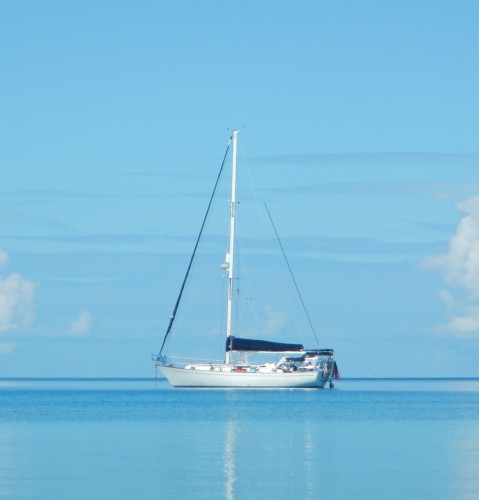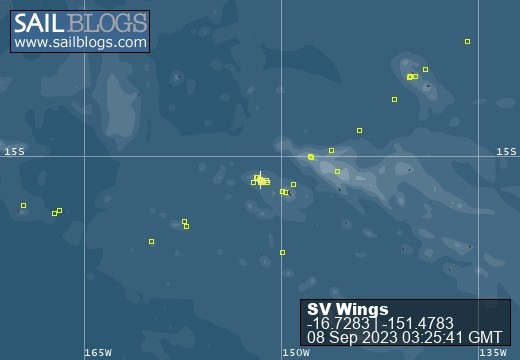
Voyages
These are the voyages of the sailing vessel, Wings.
19 September 2023 | Pension Tiare Nui
15 September 2023 | Pension Tiare Nui
13 September 2023 | Pension Tiare Nui
11 September 2023 | Pension Tiare Nui
07 September 2023 | Apooiti Bay
03 September 2023 | Tapuamu, Taha'a
02 September 2023 | Tapuamu, Taha'a
31 August 2023 | Haamene Bay, Taha'a
29 August 2023 | Relais Mehana Hotel, Huahine
26 August 2023 | Fare, Huahine
19 August 2023 | Aloe Cafe, Viatape
13 August 2023 | Aloe Cafe, Viatape
11 August 2023 | Apooiti Bay
11 August 2023 | Apooiti Bay mooring field
08 August 2023
08 August 2023 | Apooiti Bay, Raiatea
05 August 2023 | Raiatea Carenage
01 August 2023 | Raiatea Carenage
31 July 2023 | Raiatea Carenage
28 July 2023 | Orion Guest House
Progress
10 July 2022 | Oakland, CA
William Ennis | Hot!
We arrived with our baggage without incident. We are hauling 3 blue boxes weighing in at 47-lbs each, my big duffle at 48-lbs, Conni's duffle, two backpacks, and a 4-ft reverse osmosis membrane. We're in Oakland with Conni's dad. As I've mentioned before, LaVerne is an exceptionally kind man and has the tools, experience, and knowledge to provide enormous help for our boat projects.
Also as I've mentioned, problem one was how to mount the new autopilot drive. It's a bit heavier than the old one, its mounts are in a different location compared to the old unit, and it connects to the tiller arm with a smaller bolt than was drilled for the original unit. All of these provide design and fabrication problems.
To support the mount for the original drive, I used 3/4" plywood, coated in epoxy resin and fiberglassed it, vertically, into place. That provided a vertical anchor point for an "L"-shaped bracket that I fabricated. The horizontal part of the L-bracket supported the mounting foot for the old unit. The new unit's mounting foot is almost a foot further away from the plywood, so I designed and fabricated a 3/8" steel plate with holes drilled for mounting one end to the original bracket and the other end drilled for mounting the new unit. Still, the problem of floating this very heavy unit and steel plate on that bracket has concerned me and LaVerne. I finally decided to fabricate a fiberglass support that was 'glassed to the boat hull under the new unit and it would support the cantilevered weight. When I arrived in Oakland and LaVerne and I were discussing the problem, he shared a better idea: a leg protruding from below the new unit and supporting the drive. Clever! We bought a cast steel pipe flange and drilled and tapped four holes to mount the flange directly under the new unit. From that, we put together a PVC "leg" that will screw into that pipe flange and reach to the boat hull. At stress points where the leg and pipe flange met, we filled the pipe with epoxy strengthened with fiberglass fibers . The newly-modified steel plate is complete and I painted it with Rust-oleum paint. It's drying as I write this. The new design solves the mount and support problems.
The end of the drive that physically connects to the rudder arm and actually turns the rudder, uses a bolt to connect to that rudder arm. The old unit also used that same system but the bolt hole was larger. Excess space between the hole and bolt will cause wear in the bolt and arm, possibly resulting in failure at an inopportune time. After some thought, I decided to use some "shims", some thin layers of stainless steel wrapped around the mountain bolt that remove that extra space. LaVerne and I spent today cutting and fitting those pieces to fit and this project will be as complete as I can make it before arriving at the boat.
One piece of shim material was 0.012" (12/1000"), the other 0.005" (5/1000"), so both are very thin stainless steel strips. LaVerne cut pieces almost to length, then using his machinist skills, remove metal to cut them to the correct width. He used a small cold chisel and hammer to accomplish this, something that I would never have considered. Using other interesting methods, he bent the metal around a properly-sized drill bit and formed the circle of metal. Finally, he cut the pieces to length with a small Dremel tool. I doubt that I could have accomplished such a difficult task.
The wire that powers the new drive unit protrudes from the end of the unit, of course. I've been concerned about the wire getting damaged during transit, so I used filament tape to attach an old spray can top to cover the back of the unit to protect the wire. The paint top barely lasted the trip down, so I needed a new idea to provide protection to the wire. LaVerne and I found an old lye bottle of the right size and I removed the entire top and neck, leaving only a cylinder. He used epoxy to attach to the inside bottom of the bottle, a "standoff", made of some old plastic hose parts. These prevent the lye bottle from being pushed onto the wire and damaging it. Very clever! When we're ready to re-pack, I'll coil the wire inside the new protective top, slip it over the back of the drive, and tape it into place. Done.
We fly out on 12 July and begin our work. At least I've done what I can to prepare for the tasks. We've got our vaccination card images uploaded to the United Airline site and according to them, we're "ready to fly."
Also as I've mentioned, problem one was how to mount the new autopilot drive. It's a bit heavier than the old one, its mounts are in a different location compared to the old unit, and it connects to the tiller arm with a smaller bolt than was drilled for the original unit. All of these provide design and fabrication problems.
To support the mount for the original drive, I used 3/4" plywood, coated in epoxy resin and fiberglassed it, vertically, into place. That provided a vertical anchor point for an "L"-shaped bracket that I fabricated. The horizontal part of the L-bracket supported the mounting foot for the old unit. The new unit's mounting foot is almost a foot further away from the plywood, so I designed and fabricated a 3/8" steel plate with holes drilled for mounting one end to the original bracket and the other end drilled for mounting the new unit. Still, the problem of floating this very heavy unit and steel plate on that bracket has concerned me and LaVerne. I finally decided to fabricate a fiberglass support that was 'glassed to the boat hull under the new unit and it would support the cantilevered weight. When I arrived in Oakland and LaVerne and I were discussing the problem, he shared a better idea: a leg protruding from below the new unit and supporting the drive. Clever! We bought a cast steel pipe flange and drilled and tapped four holes to mount the flange directly under the new unit. From that, we put together a PVC "leg" that will screw into that pipe flange and reach to the boat hull. At stress points where the leg and pipe flange met, we filled the pipe with epoxy strengthened with fiberglass fibers . The newly-modified steel plate is complete and I painted it with Rust-oleum paint. It's drying as I write this. The new design solves the mount and support problems.
The end of the drive that physically connects to the rudder arm and actually turns the rudder, uses a bolt to connect to that rudder arm. The old unit also used that same system but the bolt hole was larger. Excess space between the hole and bolt will cause wear in the bolt and arm, possibly resulting in failure at an inopportune time. After some thought, I decided to use some "shims", some thin layers of stainless steel wrapped around the mountain bolt that remove that extra space. LaVerne and I spent today cutting and fitting those pieces to fit and this project will be as complete as I can make it before arriving at the boat.
One piece of shim material was 0.012" (12/1000"), the other 0.005" (5/1000"), so both are very thin stainless steel strips. LaVerne cut pieces almost to length, then using his machinist skills, remove metal to cut them to the correct width. He used a small cold chisel and hammer to accomplish this, something that I would never have considered. Using other interesting methods, he bent the metal around a properly-sized drill bit and formed the circle of metal. Finally, he cut the pieces to length with a small Dremel tool. I doubt that I could have accomplished such a difficult task.
The wire that powers the new drive unit protrudes from the end of the unit, of course. I've been concerned about the wire getting damaged during transit, so I used filament tape to attach an old spray can top to cover the back of the unit to protect the wire. The paint top barely lasted the trip down, so I needed a new idea to provide protection to the wire. LaVerne and I found an old lye bottle of the right size and I removed the entire top and neck, leaving only a cylinder. He used epoxy to attach to the inside bottom of the bottle, a "standoff", made of some old plastic hose parts. These prevent the lye bottle from being pushed onto the wire and damaging it. Very clever! When we're ready to re-pack, I'll coil the wire inside the new protective top, slip it over the back of the drive, and tape it into place. Done.
We fly out on 12 July and begin our work. At least I've done what I can to prepare for the tasks. We've got our vaccination card images uploaded to the United Airline site and according to them, we're "ready to fly."
Comments
| Vessel Name: | Wings |
| Vessel Make/Model: | Passport 40 |
| Hailing Port: | Anchorage, Alaska |
| Crew: | William Ennis and Constance Livsey |
| About: | We've been married since 1991, and both retired from our respective jobs (teacher and attorney) after long careers. We live in the most exotic of the United States: Alaska. We cruise on Wings for half the year, enjoying our home state the other part of the year. |
| Extra: | |
| Home Page: | http://svwings.com |
Wings's Photos - Main
No items in this gallery.
Who We Are

Who: William Ennis and Constance Livsey
Port: Anchorage, Alaska

